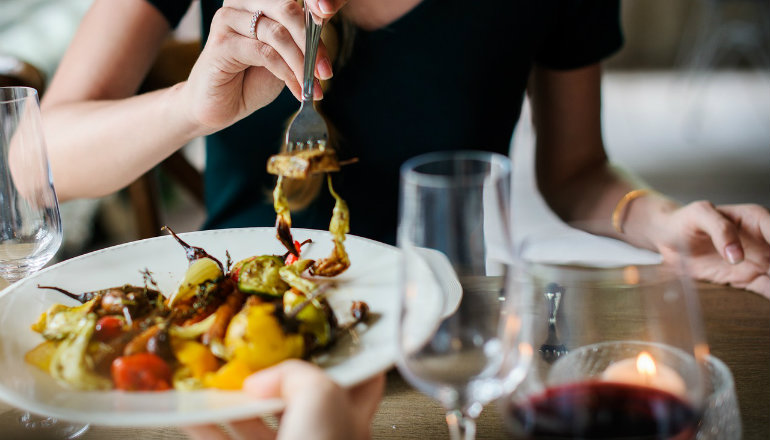
Life is about so much more than a lunch box with the perfect ratio of carbs, proteins, and fats.
Life is about travel, entertainment, and birthday parties. For many of us, dining out is one of life’s biggest enjoyments — and the biggest challenge to our healthy eating habits. To maintain our healthy lifestyle and still be able to enjoy our meals out, it is important to make educated choices so we can stay on track.
In a previous article, I talked about eating while traveling. It is a huge challenge to eat clean and healthy meals while you’re on the road, but with knowledge and a bit of preparation it can be done. But whether you’re traveling, on a business lunch, or out for a pay-day dinner with your family, we are all presented with the challenge of restaurant eating quite frequently.
Keep reading and I’ll break down a typical menu — outlining the items to avoid and the better choices available — so you’ll be equipped with all the basics of how to order healthy food when you’re eating out.

Step 1: Order Your Beverage
Most people opt for sodas when they eat out. But these are just buckets of sugar and a recipe for insulin resistance. One glass of soda has about 40g of sugar.
The issue is not the calories so much, but how the sugar wreaks havoc on your system. Basically, the soda shoots your insulin levels through the roof and shuttles all that excess sugar into your liver to be stored as glycogen and then as body fat. Juices might seem like a healthier option, but they are loaded with sugar, too, and will cause the same reaction in your body.
The issue with the sugar is especially compounded because we usually start drinking our soda before our meal has arrived, on an empty stomach. There are no fats or proteins to help slow down the release of sugar into the bloodstream. If you must have a soda (which should only be because it is a super special occasion), eat something with it to buffer the effect of the sugar overload.
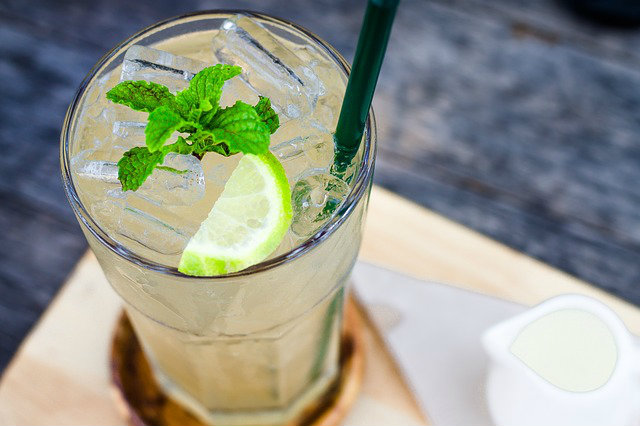
Water is always an excellent choice.
Alcohol is another no-no on my list and should only be enjoyed on special occasions. The body considers alcohol as a poison so it sends it to the liver right away to start the detoxification process. This means that if your liver is busy dealing with alcohol, it will delay dealing with other nutrients. So basically, if you eat a big fatty meal on top of the alcohol, the meal needs to wait to be processed until the alcohol has been processed.
To top it all off, alcohol is more calorie dense than sugar. Sugars and proteins contain four calories per gram, whereas alcohol contain seven calories per gram — and, needless to say, no real nutrition. This means that a beer and pizza is double whammy for weight gain.
Then there are those delicious milkshakes. There is enough fat and sugar in these things to qualify as a whole meal. I would avoid these at all costs.
- Drinks to avoid: Alcohol, sodas, juices, and milkshakes.
- Best options: Water, tea with no added sugar, and sparkling mineral water with lemon or lime.
Step 2: The Arrival of the Bread Basket
The bread, as delicious as it is with that whipped butter, should be avoided at all costs. Most breads are loaded with additional sugar and are made of refined white flour that, just like the soda, will shoot your insulin levels through the roof while providing little nutritional value. Regardless if you are gluten intolerant or not, white bread will make many people bloated and gassy, which is not a good way to spend your night out.
- Best options: Ask the server to skip your table so you’re not even tempted.
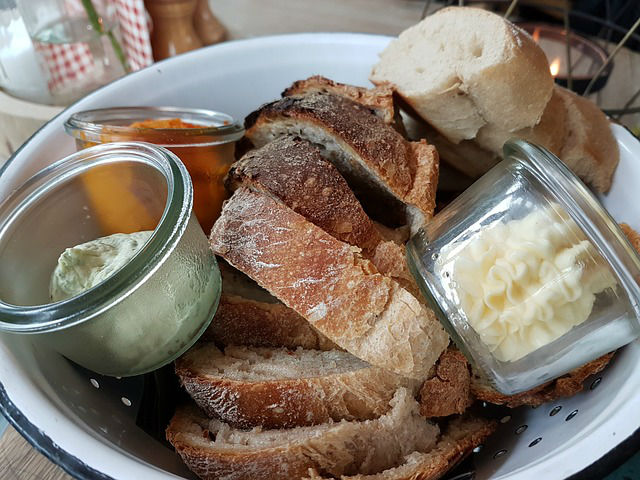
Don’t even let this come to your table.
Step 3: Choosing Your Appetizer
Generally speaking, starters are just another way to blow your nutrition plan right off the bat. Most options are loaded with excess fat, such as the creamy spinach dips, onion rings, tater tots, deep fried buffalo chicken wings, or mini pizza squares laden with cheese and salt.
If you do opt for an appetizer, choose a small plate that contains some protein such as grilled calamari, a Japanese-style sliced tuna dish, antipasto (but avoid the crackers and breads), grilled chicken and vegetable skewers, or oysters. Cooked vegetables or a side salad with lots of fresh greens are healthier options, also. Just remember to always ask for dressing on the side, that way you can control the amount you add to your salad.
- Starters to avoid: Anything deep fried such as onion rings, tater tots, or buffalo chicken wings. Creamy and cheesy dips with chips, mini pizzas, and sliders.
- Best options: Grilled calamari, Japanese-style fish dishes, antipasto without the crackers and breads, grilled chicken and vegetable skewers, or oysters. Salads with dressing on the side, chopped vegetables with low fat dips such as salsa or hummus.
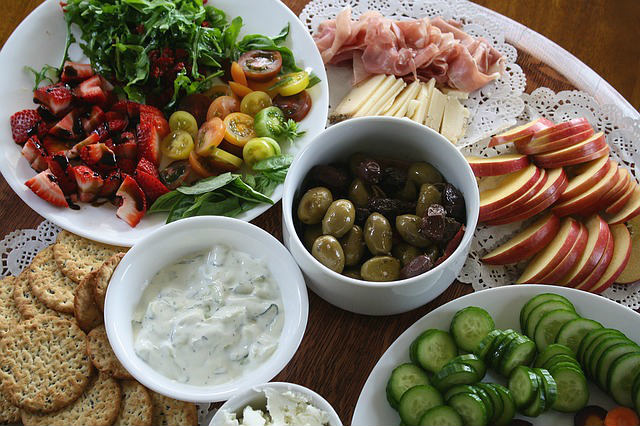
Eat the fruit, veggies, and (maybe) meat. Skip the cheese, crackers, and dip.
Step 4: Choose Your Side Dishes
Sides are another easy way to drastically overshoot our actual food-intake needs for the day. Fries are the obvious side that is often automatically added to any burger or sandwich. Sweet potato fries are an increasingly available option, but although they are marginally better than normal fries, they are still “fried” and therefore loaded with (usually not very healthy) fat.
Although they are not deep fried, I would still avoid baked potatoes because they typically come covered in cheese, margarine/butter, and salt. Other sides to steer clear of are creamed corn, onion rings, potato wedges, creamy soups like chowders, and even baked beans since they have so much added sugar.
Many meals are accompanied with breads, bagels, and muffins. Avoid these and instead ask for fruit, salad, or vegetables as a substitute. Baked, grilled, or lightly sauteed vegetables are a great option and I choose these often when I am eating out.
- Sides to avoid: All deep-fried foods such as fries, onion rings, and potato wedges. Creamy soups, baked potatoes, breads, bagels, and muffins.
- Best options: Salads with dressing on the side, steamed or grilled vegetables, and fruit.
Step 5: Decide on Your Main Course
Your best bet with mains at most restaurants is to skip right past the section of the menu that offers burgers and club sandwiches. Once again, the bread is most likely refined white flour with little or no nutritional value. In addition, most of these meals are the kind that come with fries. If you absolutely need a burger, swap out the fries for salad or fruit and remove the top part of the bun and eat your burger open-faced.

I frequently eat out, but stay in shape by making smart choices and paying attention to portion control.
The other main courses to skip are the pastas. Just like bread, most pastas are made with refined white flour. Pastas are very dense in carbs and if these carbs are not used up by your body, then they will be stored as fat. If you are eating out for dinner, sitting to watch a movie, and then going to bed, you’re not using those carbs. Unless you are hitting the club to go dancing for the five hours following dinner, then eating pasta is pretty much a guarantee to pile on the pounds.
Other items that should be avoided are deep fried fish dinners, anything “breaded,” and creamy rice dishes such as risotto. None of those things are likely have much nutritional benefit anyway.
Your best choices when ordering mains are baked or grilled fish, baked or grilled chicken, or a lean steak with vegetables. Just make sure to nix any sauces that might get added as these are usually full of sugar and other unhealthy ingredients. And remember to avoid the fries and ask for extra veggies or a side salad instead.
Alternatively, you can order a big salad. Most restaurants offer a variety of different salads packed full of healthy vegetables. Not all salads are created equal, though. A grilled chicken salad with lots of greens, sliced avocado, and some olives is a much better option than a buffalo chicken salad with deep-fried chicken, only a few lettuce leaves, and lots of other less healthy ingredients such as tortillas, croutons, cheese, candied nuts, and dried fruit with lots of sugar.
As a basic rule, avoid croutons. Dairy is troublesome for a lot of people, but if you would like to enjoy a bit of cheese, then opt for a sprinkling of feta or some goat cheese. Most of the candied nuts are sweetened with high fructose corn syrup and contain partially hydrogenated vegetable oils, so avoid those, too. Choose salads that contain raw nuts or seeds and be mindful of the sugar content of the dates, cranberries, and raisins.
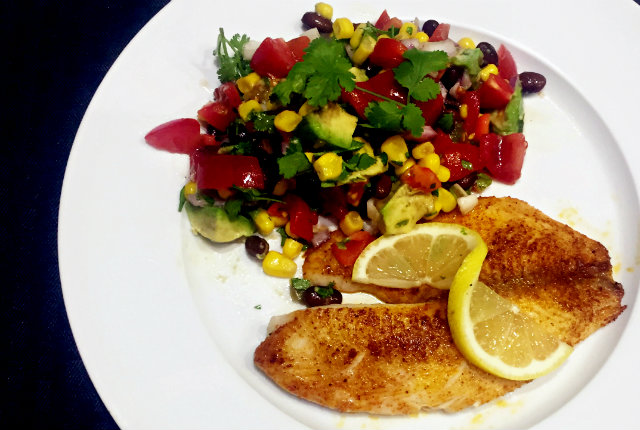
This fish dinner with bean salsa is an example of a healthy, well-rounded meal. Click here for the recipe.
Remember to ask for the dressing on the side so you can control how much to put on your salad. I also recommend avoiding the creamy ranch-style dressings. Ask for a vinaigrette made with olive oil, since that is a much healthier fat than what is often in dressings. If you don’t like any of the options available, then just ask for olive oil and vinegar — most restaurants can bring a couple bottles to your table and you can make your own dressing.
- Mains to avoid: Burgers and sandwiches served on bread or buns; deep-fried meals such as fried calamari, fish, and chicken; pasta in general, but especially creamy pasta and rice dishes. Also avoid salads with deep fried chicken and all the extras such as croutons, dried fruit, and candied nuts.
- Best options: A lean protein source such as baked or grilled seafood, baked or grilled chicken, or a lean steak with vegetables. A healthy salad with the dressing on the side.
Step 6: What About Dessert?
There is pretty much nothing on a dessert menu that is healthy-eating friendly. The rich, decadent chocolate cakes, pies, brownies, and sundaes are something to be eaten only on special occasions. If you are one of those people with a sweet-tooth who must finish the night out with a treat, the healthier options are gelatos, light mousses, or an assortment of fruit.
If I order dessert, I always share it with a few people. If you order a piece of cake, ask for enough spoons for everybody at the table. That way you are satisfying your craving, but not completely blow your nutrition plan.
- Desserts to avoid: Everything.
- Best options: Gelatos, after-dinner mints, light mousse, or a bowl of fruit.
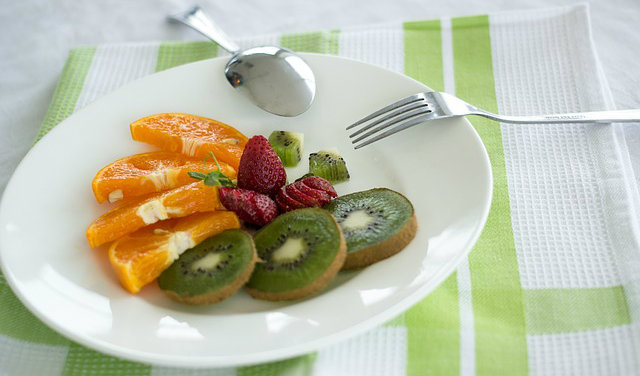
Fruit can make a fabulous dessert.
A Special Note About Serving Sizes
Let’s be honest, the serving sizes at most restaurants in America are huge. Personally, if I ate a starter plus an entree with a side and a dessert, I would feel like a stuffed pig. I would be lucky to be able to walk out of the restaurant.
A lot of eating right at restaurants is not just about choosing the right meals, but also about being mindful of overeating. I tell all my clients to avoid the starters and go straight to a main dish with a healthy side. If you really want something on the starter menu, consider ordering two starters to replace your main meal. This is something I often do. I will choose a salad with some avocado and goat cheese and also some grilled calamari or half a dozen oysters. And that’s it!
To avoid overeating, the obvious thing is to stop eating when you feel full. Ask for a to-go box and save the rest for later. Drinking plenty of water is a good way to avoid overeating since the liquid fills you up. I also eat something small just before I leave my house so I am not arriving at the restaurant starving and inclined to order everything in front of me. Nibble on some chopped fruit, veggies, or nuts before you head out the door.
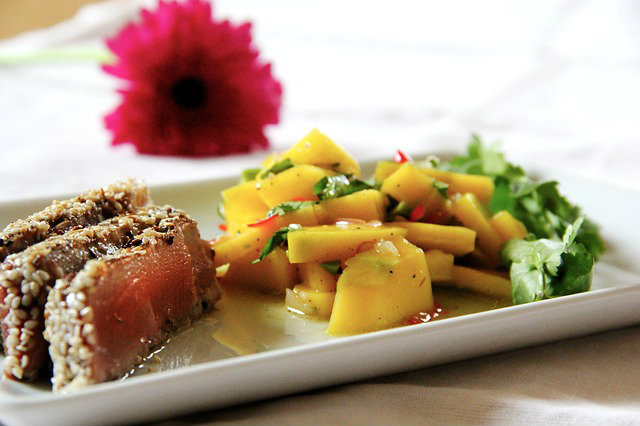
This tuna appetizer could also be a main dish.
You Can Order Healthy Food and Still Have Fun
Eating out can be a treat, it’s a great way to connect with friends and family, and it’s often how we enjoy special occasions. But dining out does not have to be an excuse to completely blow your healthy eating plan.
You can eat out, enjoy yourself, and still eat mindfully. Making some of the smarter choices I’ve outlined will keep you on track toward feeling good and looking good. Stay away from foods and drinks that are loaded with unhealthy fats and sugar, steer clear of the bread basket, and share dessert among friends instead of eating it by yourself. And if you feel full at any point, put whatever is left in the to-go box.
Moderation to everything in life is the key. Do your due diligence each week in planning and preparing most of your own meals, and eating out once in a while won’t crush your progress toward your goals.



































